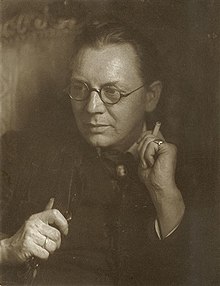Hugo Erfurth
Hugo Erfurth (born October 14, 1874 in Halle (Saale) , † February 14, 1948 in Gaienhofen ) was a German photographer . He is considered one of the most important portrait photographers of his time.
Life
Hugo Erfurth began an apprenticeship with court photographer Wilhelm Höffert in Dresden in 1895 and took over the atelier of J. S. Schröder in Dresden's Johannstadt in 1896 at the age of 22 . In 1906 he acquired the Palais Lüttichau in the Pirnaische Vorstadt , where he set up the photography workshop in Erfurth . Until the First World War he also taught a photography class in Leipzig under Professor Walter Tiemann at the Royal Academy for Graphic Arts and the Book Industry . In 1934 he moved to Cologne and opened a studio there, which was destroyed in the bombing of Cologne in 1942 . After the war he settled in Gaienhofen on Lake Constance and died there in 1948 at the age of 73.
plant
At the turn of the century he cultivated a painterly-impressionistic style of photography in the sense of pictorialism . Prints were not infrequently produced as precious oil pigment prints . Hugo Erfurth was best known for his portrait photographs , in which he implemented a very personal, psychologizing point of view representing the character of the person being portrayed in the 1920s. Erfurth found the models required for such a representation among visual artists or writers. The artist portraits that are often depicted are in the collective memory. B. by Lovis Corinth , Käthe Kollwitz , Otto Dix , Gerhart Hauptmann or Oskar Kokoschka .
Erfurth also became known as a theater photographer, but even more for his photographs of modern artistic dance taken in motion, e.g. B. from Grete Wiesenthal and her sisters, from Clotilde von Derp or Mary Wigman . His students included the Greek photographer Nelly and the German Charlotte Rudolph .
Hugo Erfurth is one of the co-founders of the Gesellschaft deutscher Lichtbildner , the oldest organization of photographers in Germany.
Graphic Cabinet Hugo Erfurth
In 1922 Hugo Erfurth opened an art shop at Zinzendorfstraße 11 under the name "Graphisches Kabinett Hugo Erfurth". The art shop opened with an exhibition of works by Oskar Kokoschka . In 1925 an exhibition with works by Emil Nolde was shown and the exhibition " 7 Bauhaus masters " was organized, u. a. with works by Paul Klee and Wassily Kandinsky , which were also shown in the Erfurt Art Association . Hugo Erfurth also supported the then young Dresden artists such as Hans Grundig , Wilhelm Lachnit and Kurt Schütze .
Namesake
An international Hugo-Erfurth-Prize for photography was donated by the city of Leverkusen and under the sponsorship of the local company Agfa , which is best known for the production of photographic films.
Lectures
- The development of portrait photography . In: Photographic correspondence . No. 50 , 1913, pp. 182-193 .
literature
- Otto Steinert (Ed.): Hugo Erfurth. Portraits. Mohn, Gütersloh 1961.
- Bodo von Dewitz, Karin Schuller-Procopovici (eds.): Hugo Erfurth, 1874–1948. Photographer between tradition and modernity. Wienand, Cologne 1992, ISBN 3-87909-312-1 .
- Peter Tausk: The history of photography in the 20th century. 2nd edition, Dumont, Cologne 1980, ISBN 3-7701-0813-2 , pp. 25 f., 65 f., 258.
- P. Hanneke: About catatypia. P. 99 ff. (Illustrated with photos of Erfurth) and Fritz Loescher: On Hugo Erfurth's pictures. Pp. 103 ff., In: Photographische Mitteilungen , Volume 40, 1903.
Web links
- Works by and about Hugo Erfurth in the catalog of the German National Library
- Directory of collections with photographs by Hugo Erfurth
- 100 theater photos by Hugo Erfurth at the University Library in Frankfurt am Main
- Materials by and about Hugo Erfurth in the documenta archive
- Hugo Erfurth: Pictures and information in the Deutsche Fotothek
- Hugo Erfurth's biography in Stadtwiki Dresden
- Katja Dannowski: Hugo Erfurth , 2008 ( SLUB ) State and University Library Dresden, Deutsche Fotothek.
Individual evidence
- ^ A b Andrea Abend: Hugo Erfurth (1874–1948) . In: The Elbhang Courier . No. 2 . Elbhang-Kurier-Verlag, 2000, p. 18 .
- ↑ Katja Dannowski: Between professional and art photography. Chapter 2 in: SLUB Dresden → Collections → Deutsche Fotothek → Photographers → Hugo Erfurth. SLUB Dresden , 2008, accessed on August 9, 2013.
- ^ Erhard Frommhold : Art trade in Dresden - A tradition of modernity . In: Dresdner Geschichtsverein (Hrsg.): Dresdner Hefte . 15th year, issue 49, 1/97, 1997, p. 66 ( digitized version ).
| personal data | |
|---|---|
| SURNAME | Erfurth, Hugo |
| BRIEF DESCRIPTION | German photographer |
| DATE OF BIRTH | October 14, 1874 |
| PLACE OF BIRTH | Halle (Saale) |
| DATE OF DEATH | February 14, 1948 |
| Place of death | Gaienhofen |

